China’s Population Declines for Third Consecutive Year Amid Falling Birthrate
China’s population has fallen for the third consecutive year, signaling a significant demographic shift in the world's most populous country. The decline, attributed to a persistently low birthrate and an aging population, poses serious economic and social challenges for the nation.
Data released by China’s National Bureau of Statistics shows that the population decreased by approximately 850,000 people in 2024, bringing the total to around 1.41 billion. This marks a continuation of a trend first observed in 2022, when the country’s population shrank for the first time in over six decades.
Declining Birthrate and Aging Population
China’s birthrate, already one of the lowest globally, fell further in 2024 to 6.8 births per 1,000 people, a historic low. Efforts by the government to reverse the trend—such as lifting the one-child policy in 2016, introducing a three-child policy in 2021, and offering financial incentives to encourage childbirth—have so far failed to yield significant results.
Experts attribute the decline to a combination of factors, including the high cost of living, housing, and education, as well as shifting societal attitudes. Many young couples are choosing to delay or forgo having children, citing economic uncertainty and work pressures.
Additionally, China is grappling with an aging population, with nearly 20% of its citizens aged 60 or older. This demographic shift is expected to strain public resources and reduce the labor force, further complicating economic growth prospects.
Economic and Social Implications
The population decline has far-reaching implications for China’s economy, which relies heavily on a large, productive workforce. Analysts warn that the shrinking population could lead to slower economic growth, reduced consumer spending, and increased pressure on pension and healthcare systems.
A shrinking labor pool may also challenge China’s position as a global manufacturing powerhouse. Companies operating in China are already feeling the pinch of rising labor costs and are increasingly exploring automation or relocating operations to other countries.
Government Response
The Chinese government is intensifying efforts to address the crisis. Local authorities in various provinces have rolled out incentives such as cash subsidies, tax breaks, extended maternity leave, and support for childcare. Nationally, Beijing is exploring policies to boost fertility rates and support families, while also encouraging older adults to remain in the workforce longer.
Demographers, however, caution that reversing the trend will require more than financial incentives. Broader reforms, including addressing gender inequality in the workplace and improving work-life balance, are critical to creating an environment where families feel supported to have more children.
Global Implications
China’s demographic shift is expected to have ripple effects globally. A slowing Chinese economy could affect international trade and investment, while the country’s diminished role as a labor-intensive manufacturing hub may lead to changes in global supply chains.
As China navigates this demographic challenge, the question remains whether it can adapt quickly enough to mitigate the economic and social fallout. Experts suggest that the country’s ability to implement effective policies will determine the long-term impact of its population decline on both domestic and global scales.


